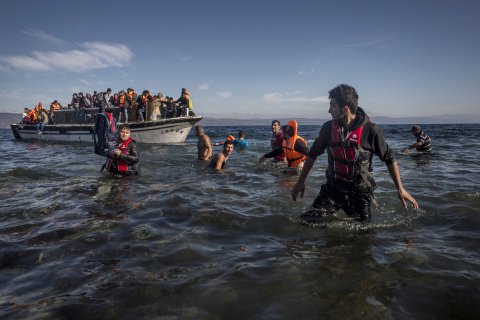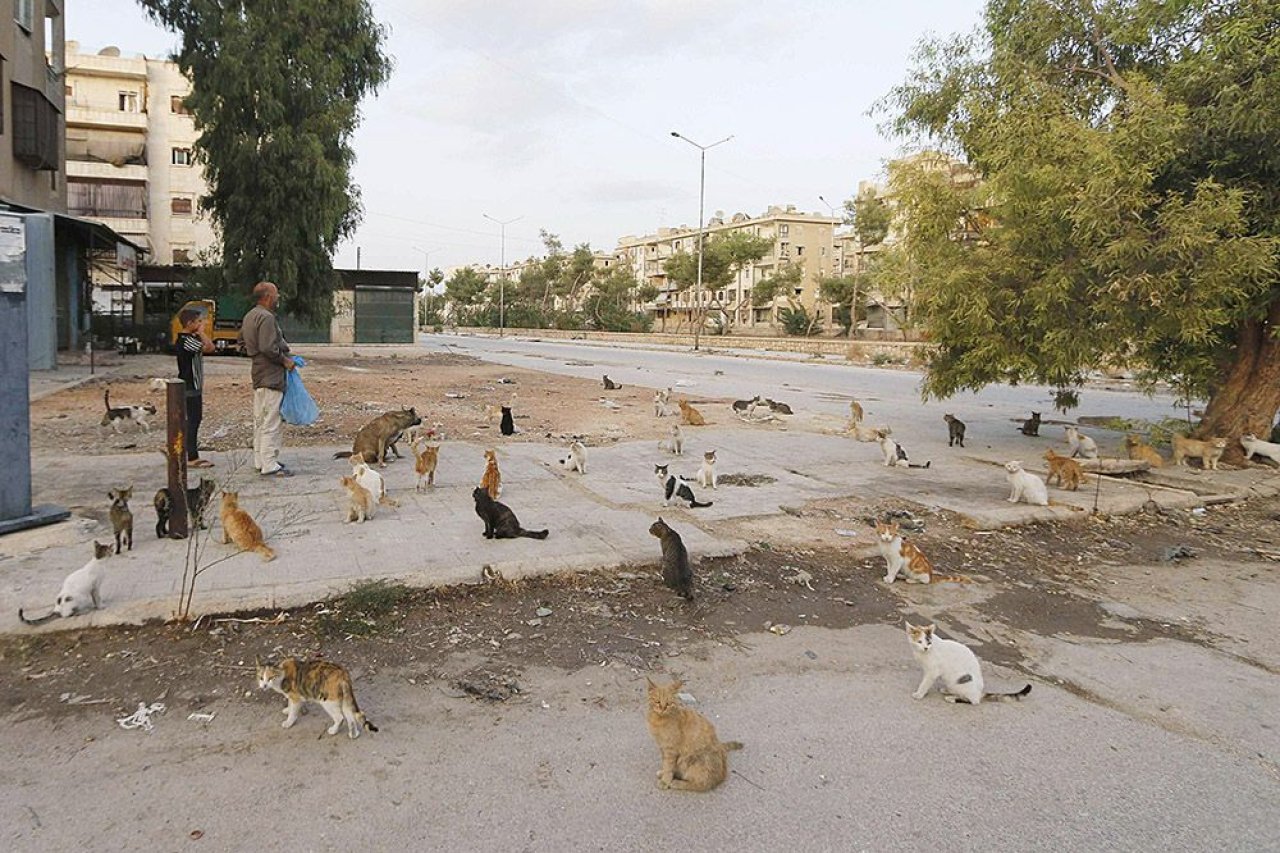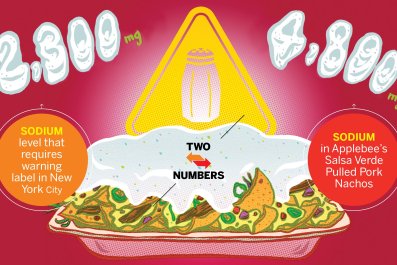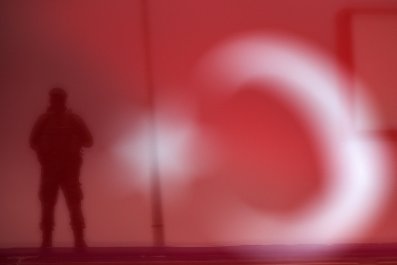Each morning, Mohammad Alaa Aljaleel drives to the local butcher shop and purchases $2.50 worth of scraps. On good days, the sympathetic proprietor will give Aljaleel a discount or even throw in some bits and bones for free. Along with everyone else in this part of Aleppo, Syria, the butcher knows Aljaleel isn't purchasing the meat for himself but for 150 street cats—most of them former pets abandoned when their owners fled the city or were killed.
In the years since the Syrian civil war broke out in 2011, Aljaleel has become his hometown's unofficial feline caretaker. Shortly after the crisis began, the former electrician had an opportunity to take his wife and three children to Turkey, where he had prospects of working as a mechanic. But along with his family, he chose to stay behind to help those less fortunate than himself. For Aljaleel, that includes not just people but also animals. "I regard animals and humans in the same light," he says. "All of them suffer pain, and all of them deserve compassion."
A lifelong cat lover, Aljaleel first noticed a few strays hanging around the rubble of a home destroyed by an airstrike. He felt compelled to feed them. Soon five animals turned into 10, then 20—as he says, "cats always find out when there's food around"—and on up until the colony reached the estimated 150 that he watches over today. Thirty of the cats now have names, including his favorite, Zorro the Noble, and children from other parts of the city come to visit the homeless pets, many of which are still very friendly. "It brings the kids so much joy to play with them," Aljaleel says. "I take great pride in the work I'm doing."

Some might argue that Aljaleel's time and resources would be better spent aiding human victims of war. But the scant few individuals and organizations that work with pets and other animals caught up in conflict zones firmly believe their efforts are worthwhile. Helping animals, they point out, helps people. Farmers' livelihoods may be wrapped up in their livestock, while cats and dogs are often beloved members of the family. Some Syrian refugees have walked over 300 miles with their dogs or taken kittens aboard rafts bound for Greece.
"The reality is that people do not want to evacuate without their pets," says Gerardo Huertas, director of disaster management operations at World Animal Protection, a nonprofit focused on improving animal welfare. "In questionnaires we've carried out asking people what they would take with them if they had to leave their homes, cats and dogs are always on the top of the list."
Inevitably, though, animals are left behind. When that happens, they often face a slow death by starvation, injury or disease. Huertas was introduced to this harsh reality in 1989, during the blood-soaked Nicaraguan Revolution. Desperate Nicaraguans were flooding across the border into Costa Rica, but the last 100 yards of the frontier were laced with land mines. Discovering this, some refugees tied their cattle and horses to trees, thinking their chances would be better if they made their way through the field on their own. They likely intended to come back for the animals at some point, but in effect those horses and cattle were left to starve.
When Huertas, who is from Costa Rica, heard about the situation on the news, he felt compelled to do something, despite the danger. "I was young and stupid," he says. So he and a friend headed to the scrubby borderland, where they retraced the path the refugees had taken, all the while praying not to get blown up themselves. Soon, they found the emaciated animals; in their desperation, they had eaten the bark off of the trees they were tied to. Some were dead. Huertas and his friend roped up the survivors into a single-file line and began the treacherous journey back to Costa Rica. Somehow, the two men and all of the animals made it through without stepping on a mine.

Huertas has gone on to aid conflict animals all over the world. He's treated livestock suffering from tuberculosis in Kosovo just a month after the 1999 cease-fire, and he has spent time in Kabul, Afghanistan, saving starving zoo animals and tending to camels injured by shrapnel. Farmers, especially, welcomed Huertas and his colleagues as heroes. "People have no future without their animals," he says.
These animal-aid missions often include a second goal: limiting the dangers that once-domesticated animals turned wild can pose to humans. During the war in Kosovo, stray sheepdogs banded together into packs that soon became feral. "They can be aggressive if they're hungry," Huertas says. "We had to round up a lot of those animals."
Feral dogs and cats can also spread rabies—a chronic problem in Afghanistan, where an estimated 1,000 people die each year because of bites from infected canines. "In the last few months, 12 people died of rabies in the outskirts of Kabul alone," says Pen Farthing, founder and CEO of Nowzad, a nonprofit organization that runs the only official animal charity in Afghanistan. To combat the disease, Nowzad practices trap-neuter-release, harmlessly capturing feral animals, "fixing" them and vaccinating them for rabies, and then returning them to the street. Simply euthanizing stray dogs would not work, Farthing says, because Kabul has too many of these extremely territorial animals; if some were eliminated, others would immediately move in.
Unfortunately, Nowzad's Kabul clinic and World Animal Protection's global operations are exceptional examples among conflict-torn areas. Very few nonprofits operate in places plagued with violence, primarily because of the danger such settings pose to human rescuers. Farthing, a former Royal Marine commando, has had to deal with improvised explosive devices planted outside the animal shelter (intended for Afghan army vehicles), and one of the nonprofit's drivers once passed through an area that the Taliban attacked five minutes later. Soldiers stopped Huertas and his colleagues at gunpoint in Kosovo and, according to their translator, began deliberating about whether or not they should shoot the foreigners.

Safety aside, logistics for animal rescue in such places can also be daunting. Aid workers must bring along enough veterinary supplies and food to restock local clinics and get shelters up and running, along with oddball equipment like dart guns for catching aggressive dogs and humane euthanasia devices to give to slaughterhouses. "Just to put one of those things on a plane is a big deal," Huertas says. "Explosive cartridges and drugs are the biggest no-nos for airlines."
Nowzad regularly attempts an even greater logistical feat, however: sending dogs and cats from the Middle East to the U.S. or Europe. When Farthing was stationed in Afghanistan, he once stopped a dogfight that some Afghan policemen had instigated. To his surprise, he says, "One of those dogs decided to adopt me." The town where that occurred, called Nowzad, served as inspiration for both his new pet's name and his future charity. When he left the country in 2007, he brought Nowzad the dog back with him to the U.K. However, he found that doing so was a significant challenge. The dog needed the proper vaccinations, provided by a qualified vet, to meet the health requirements of the new country; Farthing needed to find a facility where the animal could stay during its quarantine period before it got those vaccines; the dog needed a way to actually make the journey, on either a commercial flight or a cargo plane; and Farthing had to manage the paperwork and permissions needed to bring an animal from Afghanistan to the U.K.
Farthing's situation is not out of the ordinary. Soldiers stationed abroad often defy army regulations and adopt local animals, which they are reluctant to part with when their tour of duty concludes—but they also are not able to manage jumping through all the hoops to get the pets safely home. So far, Nowzad has reunited 800 soldiers with their animals from Afghanistan and 40 with theirs from Iraq. War Dogs Making It Home, a charity in Chicago that trains rescued dogs as service animals and pairs them with combat veterans suffering from post-traumatic stress disorder, traumatic brain injury or mobility issues, has also brought six Nowzad dogs to the U.S . Those animals, however, are the exceptionally lucky ones. Most suffer fates like that of J-bad, a mortally wounded Afghan dog that rescuers found in 2014.

That year, Dan Tatsch, a five-time Nowzad volunteer from Dallas and former U.S. Army captain, was on his way to the Kabul airport to catch a flight home when a call came through from a Canadian logistics contractor. The woman had spotted a crippled dog dragging itself by its front legs along a dangerous stretch of highway called Jalalabad Road. Tatsch, Farthing and the other Nowzad team members in the van had enough time before Tatsch's flight to make a detour, and they quickly located the dog. "It was a once-magnificent example of the Kuchi herding breed, well over 100 pounds in his prime, but now a sad, broken shell of his former self," Tatsch recalls. The team scooped up the dog, whose hind legs were paralyzed—likely from a broken back—and covered in open sores from being dragged across the ground. They named him J-bad after the road he was found on. But saving his life, they knew, was out of the question; the damage was simply too great. Back at the Nowzad headquarters, the best they could provide was final meal and then a comfortable end to his suffering.
As for the cats of Aleppo, their future is uncertain—as is Aljaleel's. "Every day, when I leave my house, I know I might not return," he says. "In Syria, it's only going from bad to worse." Yet despite the escalating violence, he has no plans to leave or give up on the cats. Instead, like Farthing in Afghanistan, he has aspirations of opening his own animal shelter and hospital. "I'm aware that other countries have lots more resources for animals, but here we don't even have many good doctors, let alone veterinarians," he says. "Although there is no such thing as animal shelters in Syria now, I dream of building one."






















